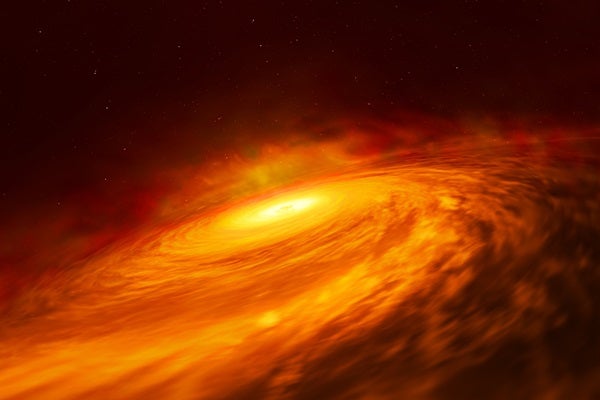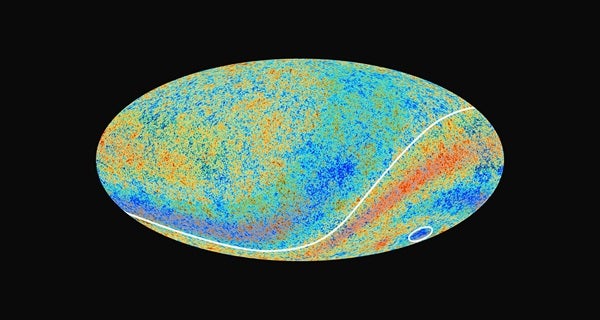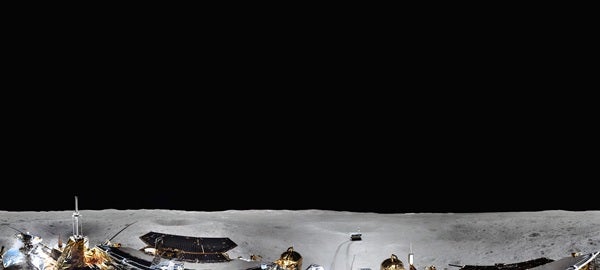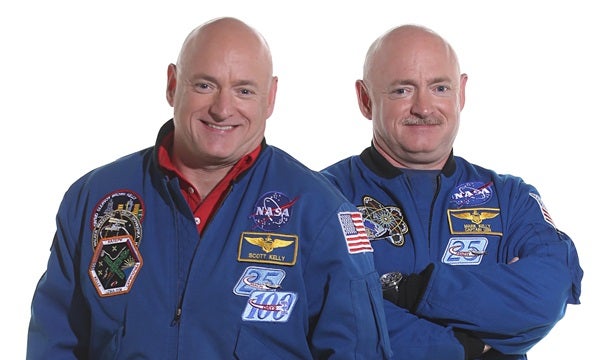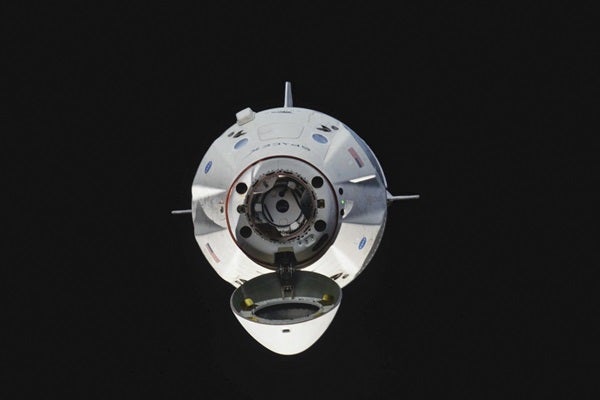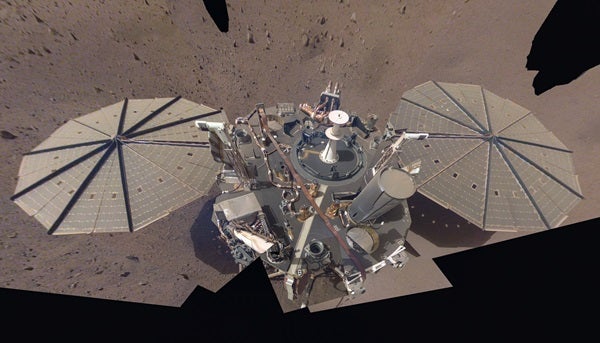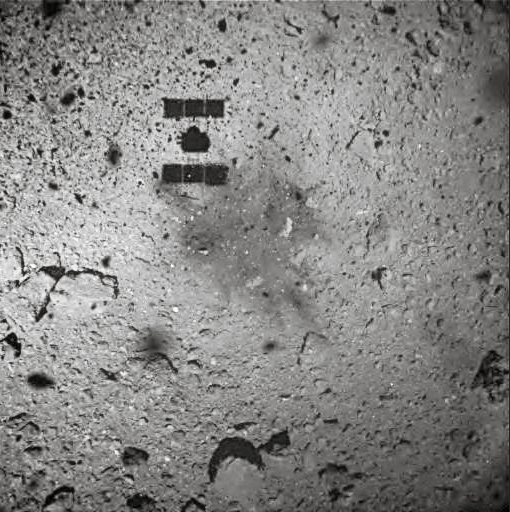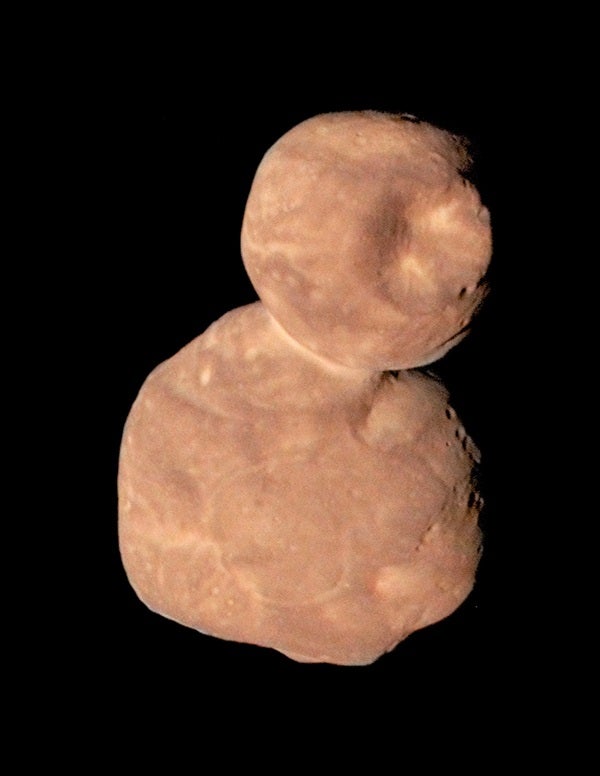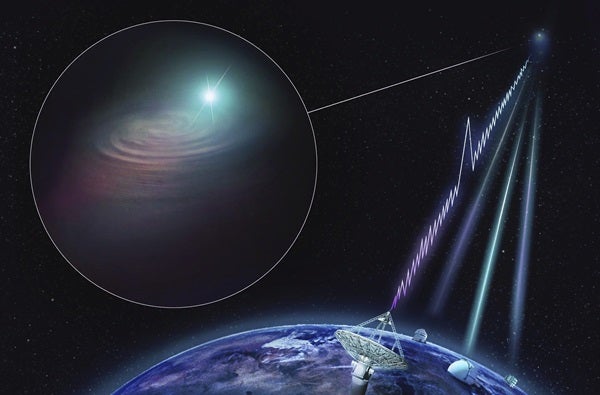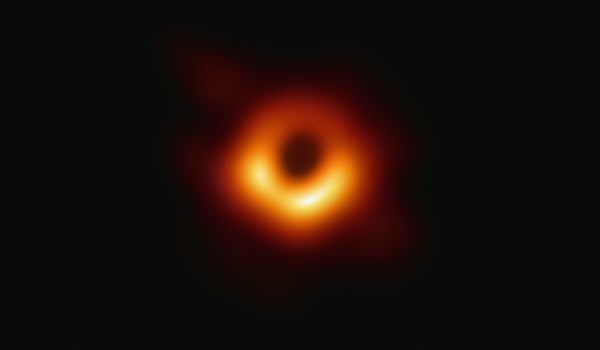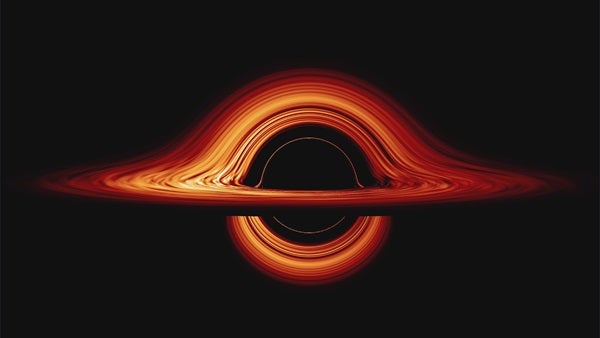Far from home, astronomers still seek to understand strange features in our current picture of the early universe. Uncovering what these anomalies mean will tell us more about how the cosmos was born and what it was like in its infancy. Researchers have now begun tracking mysterious one-off bursts of radio waves back to galaxies billions of light-years away, building an ever-clearer picture of what might cause these cosmic fireworks. But the biggest story of 2019 has been decades in the making: Astronomers released the first-ever image of the shadow cast by a supermassive black hole on its swirling surroundings, using a virtual telescope the size of our planet.
We hope each story in our top 10 list shows just how far and how fast science is advancing as we seek to understand every aspect of the universe around us.
When Voyager 2 flew past Neptune in 1989, it revealed six moons circling the ice giant that astronomers hadn’t seen from Earth. But at least one more didn’t come out to play with the spacecraft. Instead, it remained hidden until Mark Showalter of the SETI Institute pored over more than 150 archived images of Neptune taken by the Hubble Space Telescope between 2004 and 2009. The new moon was so difficult to spot, in fact, that it required combining several images together to artificially extend their exposure times, then searching for the object based on where it should be, given Newton’s laws of motion, to confirm its presence.
The trick worked. Showalter — who also helped discover Pluto’s moons Kerberos and Nix — and his colleagues announced the new moon, dubbed Hippocamp, in a paper published February 20 in Nature. “We weren’t expecting new moons,” Showalter says of the effort. “It was quite a thrill.”
Originally designated S/2004 N1, the tiny moon is just under 11 miles (17 kilometers) across. That makes it Neptune’s smallest. Showalter and his team believe, based on its orbit and size, that Hippocamp is a chip off the old block — or rather, off another neptunian moon: Proteus. Discovered by Voyager 2, Proteus is one of the ice giant’s larger satellites, with a diameter of about 260 miles (420 km). It also sports a large impact crater marring most of its surface — and Hippocamp may be a piece knocked off by that impact.
Although Hubble spotted the moon, it can’t see the world in enough detail to reveal much more than its presence. “It’s a completely unresolved dot,” Showalter says. “We don’t have telescopes to resolve it, and that’s what you would need to do to figure out its surface.”
A Neptune orbiter mission could change that, he says. Although none is currently planned, the ice giant and its moons remain high on the list of places that planetary scientists want to send robotic explorers, so our first up-close look at Hippocamp may come within a few decades.
9: The cosmic cold spot conundrum continues
The earliest snapshot of our universe, dubbed the cosmic microwave background (CMB), comes from 380,000 years after the Big Bang. From 2009 to 2013, the European Space Agency’s Planck mission, with significant participation by NASA, returned the most detailed measurements of the CMB, charting tiny fluctuations in its light. These fluctuations hold a wealth of information, allowing us to tease out details about the Big Bang and the early universe.
But some details are perplexing. “At very large scales, there are strange effects that leave us a little less than completely comfortable operating the standard model [of cosmology]” that scientists use to describe the universe, says Krzysztof Górski, a senior research scientist at NASA’s Jet Propulsion Laboratory in Pasadena, California. Among those effects: The temperature fluctuations of the CMB sky seem divided into two hemispheres: a less “wrinkled” northern one, and a more wrinkled southern one, in which the hot spots are hotter and the cold spots are colder. And the southern hemisphere contains a strangely large cold spot that spans about 10° on the sky.
The standard model describes very well many other aspects of Planck’s view of the cosmos. So, the question is: What do these anomalies tell us about the early universe?
In a paper published June 6 by the Planck Collaboration in Astronomy and Astrophysics, researchers including Górski analyzed Planck’s newest publicly released data. These include improved all-sky maps of CMB polarization, which records how the CMB photons that we now observe have scattered off ionized matter — such as electrons not bound in atoms — in the universe since they were first emitted. Finding places where peculiar patterns in temperature and polarization fluctuations overlap, they hoped, might offer insight into what caused the temperature anomalies.
But while Planck measured CMB temperature fluctuations extremely well, it was not originally designed for polarimetry, Górski notes. Although its all-sky maps of CMB polarization are the best available, they represent the limit of the satellite’s capabilities to even measure tiny fluctuations in the CMB’s polarization across the sky, he says. To the best of Planck’s ability to measure, the CMB polarization gives no clues as to why various regions of the CMB sky appear discernibly different, and isn’t the key astronomers were hoping for. The temperature anomalies could be random fluctuations, rare but not completely unexpected, or caused by some as-yet-unknown process. But astronomers can’t point to a clear explanation just yet. “The cut-and-dry statistical statement is you can’t really tell one way or another,” Górski says.
Understanding the CMB anisotropy anomalies will hopefully tell us something fundamentally important about the early universe, he says. But newer, better polarization measurements are needed to determine their cause. For now, the cosmic mystery remains unsolved.
2019 marked the 50th anniversary of the first crewed Moon landing. But Apollo astronauts only set foot on the lunar nearside. At 10:26 A.M. Beijing time January 3 (10:26 P.M. Eastern Standard Time January 2), the farside got a little closer when China’s Chang’e-4 lander successfully became the first craft to soft land there. Later the same day, the lander deployed its refrigerator-sized rover, Yutu-2.
Chang’e-4 touched down in Von Kármán Crater, within the Moon’s South Pole-Aitken Basin. In February, the International Astronomical Union’s Working Group for Planetary System Nomenclature approved the name Statio Tianhe for the craft’s landing site. Chang’e-4 and its rover study the lunar farside’s geology during the daytime, which lasts about two weeks. During the two-week-long night, the pair power down until the Sun rises again.
The lander’s miniature biosphere experiment wowed the world in mid-January with photos of the first plants to grow on the Moon: cotton seeds that sprouted and grew for about a week before succumbing to nighttime temperatures of roughly –290 degrees Fahrenheit (–180 degrees Celsius). By late June, the Yutu-2 rover had far exceeded its expected three-Earth-month lifetime and driven more than 700 feet (213 meters) from the lander. The mission’s initial results include discovering that the top layer of lunar soil reaches lower temperatures than those measured by Apollo astronauts on the nearside, possibly because of differences in soil composition between the Moon’s two hemispheres. By early October, the pair had completed 10 lunar days of work.
China’s next robotic lunar mission, Chang’e-5, is slated for launch by the end of 2019. Chang’e-5 is a sample return mission, aiming to return the first new samples from the lunar surface since 1976. If all goes well, the Chang’e name may return to our list in 2020.
From March 2015 to March 2016, now-retired astronaut Scott Kelly lived and worked on the International Space Station. During that time, Scott’s identical twin brother, Mark — also a retired astronaut — went about his daily life on Earth. Because identical twins share everything, right down to their DNA, the brothers are the basis of NASA’s Twins Study, which compares their bodies pre- and post-flight. The goal is to learn more about the changes humans undergo as a result of living and working long term in space.
On April 12, 2019, the 10 research teams associated with the study published a summary paper in Science. Each of their projects focused on a different aspect of human health, such as metabolism, DNA replication, gene expression, cognition, immune response, and microbiome. Some of the body’s functions, such as immune response to vaccination, did not change during spaceflight. But the teams did note changes in Scott’s body weight, gene expression, gut microbiome, carotid artery thickness, and even the length of his telomeres — the protective caps at the end of DNA strands — among others.
Most changes persisted while Scott was aboard the space station and returned to baseline after time spent back on Earth. For example, thousands of Scott’s genes changed the way they turned on and off during spaceflight. In particular, his body activated several genes that remained dormant in Mark — a response, the researchers believe, that shows his body adapting to his new environment. Within six months of returning to Earth, more than 90 percent of Scott’s gene expression levels had returned to normal.
Some changes were unexpected. The telomeres that protect our DNA shorten as we age or in response to certain stressors. The team expected Scott’s telomeres would shorten in comparison with Mark’s while Scott was in space, a more stressful environment. But Scott’s telomeres instead grew longer during spaceflight, while Mark’s stayed the same. Upon returning to Earth, Scott’s telomeres shortened back to normal within 48 hours. And several months later, Scott had more short telomeres than before embarking, indicating at least some effects of spaceflight may be long-lived.
The results are still good news for future astronauts on missions such as extended stays on the Moon or journeys to Mars. “Overall, the findings were that, ‘Hey, there are no showstoppers in going to Mars,’ ” Scott says. But “there are areas we need to investigate further,” he adds, such as the genetic changes he underwent. It’s also vital, he says, to determine how to better protect astronauts from radiation. “From a physiological perspective I think that’s the longest pole in the tent, so to speak, to going to Mars,” he says.
But the most notable result, according to Scott? “After spending a year in space, I am now not only smarter, but also better-looking than my brother Mark.”
6. Public and private spaceflight takes off
Several organizations began ramping up their human spaceflight agendas last year. On March 26, Vice President Mike Pence announced America’s intentions to return humans to the Moon by 2024. The new lunar endeavor, named Artemis, will utilize NASA’s next-generation rocket, the Space Launch System, and the Orion spacecraft, currently undergoing testing. The program’s first mission, Artemis 1 (formerly called Exploration Mission-1), will send an uncrewed Orion capsule 280,000 miles (450,600 km) from Earth — and thousands of miles past the Moon — over the course of three weeks in 2020, in preparation for future crewed missions to Earth’s satellite and beyond.
On May 9, Amazon owner and Blue Origin manufacturing and spaceflight company founder Jeff Bezos unveiled the Blue Moon lander, designed to carry up to 6.5 tons of crew and cargo to the lunar surface. Blue Origin aims to reach Earth orbit by 2021 with the launch of its New Glenn rocket.
SpaceX’s Crew Dragon capsule on March 2 made its first spaceflight after launching atop a Falcon 9 rocket. The uncrewed capsule successfully docked with the International Space Station (ISS) and returned to Earth on March 8. The mission proved the functionality of the craft’s parachutes in slowing the capsule’s descent to ensure a safe splashdown once crew are onboard.
On February 21, Virgin Galactic’s SpaceShipTwo, VSS Unity, reached space for the second time, following its first successful flight in December 2017. Unity carried pilots Dave Mackay and Michael Masucci, as well as Virgin Galactic’s chief astronaut instructor, Beth Moses. The ship reached an altitude of just under 56 miles (90 km); NASA defines the boundary of space as 50 miles (80 km) above sea level. On July 9, Virgin Galactic announced it would merge with Social Capital Hedosophia in the latter half of 2019, creating the world’s first publicly traded company dedicated to human commercial spaceflight and gaining the capital needed to fully commercialize SpaceShipTwo.
“I want people to realize that we’re doing this — humanity is doing this today,” Moses says. “Companies beyond Virgin Galactic are currently developing systems for private citizens to fly to space and it really unifies everyone. I think it’s cool. And I think it’s important. There’s some thread of importance in there. It brings people together.”
But 2019 also saw several goals slip through spacefarers’ fingers. On April 20, just weeks after its successful ISS trip, the Crew Dragon capsule experienced an “anomaly” during a test of its SuperDraco engines at the Kennedy Space Center in Florida. Following an investigation, SpaceX announced that a leak allowed liquid oxidizer to enter and damage a valve in the system providing propellant to the engines, which are used during an emergency launch abort procedure. The leak ignited the valve, causing an explosion that destroyed the capsule.
That same month, Boeing announced the delay of uncrewed test flights of its CST-100 Starliner, also designed to ferry astronauts to and from the ISS. The first uncrewed ISS trip for the Starliner is now slated for December 17, 2019. The next Crew Dragon launch, NASA said July 30, will be no earlier than November 15, 2019.
Despite these slips, 2020 is sure to bring more spaceflight firsts, so stay tuned.
5: InSight sets up shop on Mars
NASA’s InSight mission — short for Interior Exploration using Seismic Investigations, Geodesy, and Heat Transport — landed on Mars November 26, 2018, charged with a unique task: explore the Red Planet’s interior. Its cameras and weather monitoring instruments immediately began sending information back, while the lander took several weeks to set up shop in Elysium Planitia near the planet’s equator.
In the ensuing months, the spacecraft has operated flawlessly, says Bruce Banerdt, InSight’s principal investigator and principal research scientist. So has the mission’s Seismic Experiment for Interior Structure (SEIS), which detected its first small marsquake April 6, 2019. Since then, SEIS has recorded several events each week, with more than a dozen that researchers believe are real quakes. Oddly, most of the observed marsquakes are small, with few of the larger events that the team had expected. “We don’t know yet whether that’s just the statistics, or whether it just means that Mars has a little bit different distribution of the way that it releases its seismic energy than Earth and the Moon,” Banerdt says. If it’s the latter, he says, “that’s really an exciting possibility, that we’re going to learn something fundamentally new about the way planets work in a physical sense.” Many of the events also have strange signals not reminiscent of earth- or moonquakes, which is both an unexpected and exciting find, he says.
InSight’s radio science and meteorology packages are also returning valuable data, while the craft’s cameras have allowed additional science, including geological studies.
There has been one snag. On February 28, 2019, the Heat Flow and Physical Properties Package, HP3, released its self-hammering probe, the “mole,” into the soil. Meant to burrow as deep as 16 feet (5 m) and directly measure the planet’s subsurface temperature, the mole instead got stuck just hours later, reaching a depth of only 14 inches (35 centimeters). “The layers of dirt just below the surface appear to be somewhat cemented. They’re stronger than we expected,” Banerdt says.
Although the setback has been disappointing, the team devised a plan to get the mole moving again. On October 17, NASA announced that pressing InSight’s scoop against the mole had increased friction on the probe enough to get it moving again. Since October 8, the agency said, the mole had dug another 3/4 inch (2 cm), indicating to engineers there were no rocks halting its progress and renewing hope that the experiment could proceed.
“For the most part, things are going extremely smoothly,” Banerdt says of the mission. “The thing about this mission is it takes patience. Everything that we do on this mission is accumulating data and the more we get, the better our science is.”
InSight is definitely off to a good start. The initial mission duration is 708 sols, or nearly two Earth years. After that, Banerdt says, the team will petition NASA for an extension. So it’s a good bet that InSight will continue to appear in the news for some time to come.
4: Hayabusa2 plays tag with asteroid Ryugu
In June 2018, the Japan Aerospace Exploration Agency’s (JAXA) Hayabusa2 spacecraft began its exploration of the near-Earth asteroid Ryugu. In October 2018, the spacecraft dropped its Mobile Asteroid Surface Scout (or MASCOT) lander to examine the asteroid up close. Hayabusa2 itself was scheduled to swoop down and touch the surface to collect samples the same month, but researchers discovered that Ryugu’s terrain is unexpectedly rugged. The landscape is jagged and pebbly, with no smooth powdery areas for easy sampling, so JAXA delayed the touchdown to ensure they could find a safe landing spot.
It was worth the wait. On February 22, 2019, JAXA announced that Hayabusa2 had successfully descended to the asteroid, launched a small tantalum projectile into the surface, and “tagged” Ryugu with its 40-inch-long (1 m) sampler horn to collect the resulting debris.
On April 5, Hayabusa2 upped the ante, dropping its explosive Small Carry-on Impactor (SCI) toward the asteroid. As the SCI slowly descended, the spacecraft took cover on the other side of Ryugu, leaving its DCAM3 camera about a half-mile (0.8 km) away to observe the explosion. On April 25, Hayabusa2 confirmed the SCI had generated a crater 66 feet (20 meters) wide, bringing up material from beneath the asteroid’s surface for further study.
But it took months of observing the new crater to determine the best location for Hayabusa2’s finale: On July 11, the craft again swooped down to the surface, fired its second tantalum projectile into the crater it had created, and gathered the results before retreating for the final time.
The spacecraft has now achieved all its main objectives, including retrieving the first sample of material from beneath the surface of an asteroid. “The Japanese have really made exploration history with this mission,” says Deborah Domingue, senior scientist and deputy director at the Planetary Science Institute and Hayabusa2 participating scientist. “This is not an easy engineering project. They made it look easy and it’s not.”
Once those samples are brought to Earth, she says, the science return will be enormous. Not only will researchers get a look at how the asteroid’s surface layer has been processed by space weathering such as radiation and impacts, but they will also get a peek at undisturbed, unprocessed material from within the man-made crater. By combining those samples with remote sensing data such as images and spectra taken by the spacecraft, Domingue says, researchers will be able to extrapolate what they learn from the samples to other places on Ryugu. And that will teach scientists how space changes the surface of an asteroid over time.
The remote sensing data have already given scientists plenty to work with, including several indications that the 2,900-foot-wide (880 m) Ryugu formed from debris that broke off a larger parent asteroid long ago. It’s surprisingly dark and dry, devoid of hydrated minerals, indicating its parent was likely also water-poor. That has implications for how Earth did — or didn’t — get water during the planet’s formation, as scientists believe asteroids may have delivered much of it.
Hayabusa2 will remain at Ryugu until December, when it will turn and head for home with its precious cargo.
Astronomy kicked off 2019 in high gear: At 12:33 A.M. EST on January 1, New Horizons made its closest approach to 2014 MU69, nicknamed Ultima Thule. It is the most pristine distant world ever explored — albeit remotely — by humans.
The craft zipped by the Kuiper Belt object (KBO) at a distance of about 2,175 miles (3,500 km). From its location about 4 billion miles (6.4 billion km) from Earth and 1 billion miles (1.6 billion km) past Pluto, it took more than six hours for the first images, traveling at light-speed, to reach Earth.
“It always is really exciting to see a world for the first time, just revealed before your eyes,” says Anne Verbiscer, a research professor at the University of Virginia and assistant project scientist for the New Horizons Kuiper Belt extended mission. “Just overnight, going from this tiny little dot, a speck in a telescope image or a spacecraft image, into a resolved world — that experience is rare, unique, and takes your breath away every time it happens. It’s amazing.”
The images confirmed Earth-based observations that MU69 is a bi-lobed object called a contact binary, which occurs when two separate bodies slowly spiral closer until they touch and form a single body. It spins once every 15.92 hours around a point where the two lobes connect.
Almost exactly 22 miles (35 km) at its longest, Ultima Thule had appeared on approach like a snowman, with two spherical lobes. Images snapped by New Horizons, however, allowed researchers to watch background stars disappear behind the object, revealing a different shape. The larger lobe (nicknamed Ultima) is flat and shaped more like a pancake, while the smaller lobe (Thule) has greater girth, roughly the shape of a football or walnut.
“[The two pieces] originated separately, but probably not that far from each other because they’re so similar,” Verbiscer says. “They have the same reflectivities on their surface, same composition, not a lot is different about them other than size.”
The surface of Ultima Thule is red; the color likely comes from tholins, which are compounds created by interactions between sunlight and molecules containing carbon, such as methane or ethane. Occasional craters pockmark the surface, likely the result of past impacts, but not as many as expected. “We should be seeing more of those and we don’t. But when you start thinking about how porous it is and how low-density it is, would an impact crater even look the same as it does on, say, something bigger like Pluto or the Moon? Probably not,” Verbiscer says.
The New Horizons team published their first official results in the May 17 issue of Science, a mere four months after the flyby. By September, much of the data had been downloaded, although images taken before and after the encounter, which do not include Ultima Thule but still provide clues about its environment, are still on the spacecraft, Verbiscer says. Still aboard as well, she says, are images New Horizons has taken of other KBOs as it flies through the Kuiper Belt. It will continue to do so for the rest of its extended mission, giving astronomers a closer look at these objects than they can attain from Earth.
And because Ultima Thule “is not extraordinary in any way,” Verbiscer says, researchers can compare their findings with the less detailed observations of other KBOs to draw conclusions about the objects in the distant reaches of our solar system, which represent pristine pieces of the solar nebula from which the planets were born.
“This is the first time we’ve ever seen an object from this part of the solar system,” Verbiscer says, “and it gives us a window into what the early solar system looked like. It’s just an incredible thrill and a privilege, really, to be in one of the front-row seats as this unfolds. We’re writing the textbooks here on how the solar system was put together.”
2: FRB science starts really popping off
Since fast radio bursts (FRBs) flashed onto the scene in 2007, these powerful, milliseconds-long blips of radio energy have intrigued astronomers. Most FRBs appear and disappear only once, and astronomers don’t know what they are — only that they originate outside our galaxy. In 2012, astronomers discovered the first repeating burst, FRB 121102, and in 2017, they tracked the repeater to a dwarf galaxy 2.5 billion light-years away. In 2019, astronomers again made FRB history with the discovery of nine additional repeating FRBs, as well as, for the first time, tracking two non-repeating FRBs to their hosts.
Astronomers announced in work published in Nature January 9, 2019, that the Canadian Hydrogen Intensity Mapping Experiment (CHIME) had spotted the second-ever repeater, cataloged as FRB 180814.J0422+73. In August 2019, CHIME team members announced the discovery of eight more repeating FRBs, boosting in a single year the number of known repeaters from one to 10.
Current theories suggest that FRBs come from compact objects with high magnetic fields, such as neutron stars, black holes, or mergers between white dwarfs. But whether the cause is one, all, or a combination of those options remains unclear. More repeaters lend credence to the idea that not all FRBs come from the same types of sources. “There are a lot of theories of what FRBs might be, and some of them predict that they are cataclysmic — they are only one-off events, some kind of explosion that’s created the burst. But now if you have to explain these repeating bursts, then you need to come up with another theory that can generate bursts again and again,” says CHIME team member Cherry Ng of the Dunlap Institute for Astronomy and Astrophysics at the University of Toronto.
But repeating FRBs were not all 2019 had in store. On June 27, astronomers announced they’d tracked, for the first time, a non-repeating FRB to its home galaxy. The burst, FRB 180924, was spotted September 24, 2018, with the Commonwealth Scientific and Industrial Research Organisation’s Australian Square Kilometre Array Pathfinder radio telescope. Using technology to isolate the moment the array had received the burst, the team evaluated the billionths-of-a-second differences in the time it took each dish in the array to detect the flash. The technique, called interferometry, provided a precise location on the sky where the burst had come from: the outskirts of a massive galaxy, DES J214425.25−405400.81, about 3.6 billion light-years away.
Days later, on July 2, a team led by Vikram Ravi at Caltech’s Cahill Center for Astronomy and Astrophysics announced they’d used the ten 4.5-meter dishes of the Deep Synoptic Array-10 at Caltech’s Owens Valley Radio Observatory to track FRB 190523 to its home galaxy PSO J207.0643+72.4708, about 7.9 billion light-years away.
“By looking at galaxies, you can say a lot about the stellar populations in the galaxy,” Ravi says. And learning about the stars, gas, and dust in the galaxy is crucial, he says, to determining the cause of FRBs and whether their progenitors are strange or commonplace. The host galaxies of the non-repeating FRBs are remarkably similar. Both with about the same heft as the Milky Way, they are older galaxies that aren’t forming many stars. That’s in sharp contrast to the home of the repeater FRB 121102, which is about a thousand times less massive than the Milky Way and forming stars at a rapid pace. FRB 180924’s location rules out its galaxy’s central supermassive black hole — about 13,000 light-years away from the FRB — as its source. And both massive, quiescent host galaxies reduce the chances that these FRBs are related to supernovae, which occur less frequently in older galaxies.
One thing is for sure: The mystery of FRBs is only deepening. “I think being able to leave every option on the table, however strange it might be, and investigate every possible avenue, is really interesting and allows you to think in more creative ways,” Ravi says. Finding more FRBs and tracing them to their homes will be key to learning what causes them. Both Ng and Ravi speculate that perhaps all FRBs repeat over time. “Repetition is also a question of timeline. If you look longer, they might pop up again,” Ng says.
Only time will tell.
Black holes are ubiquitous in our universe. We have seen them gravitationally act on objects that come too close, and we have charted the swirls of matter that fall into them. But, of course, black holes are black. And anything that gets too close to the black hole — beyond a point of no return called the event horizon — is gone forever. Not even light can escape.
But a black hole does cast a shadow on the bright material around it. And on April 10, the Event Horizon Telescope (EHT) Collaboration released the first-ever image of the shadow cast by a black hole, made possible by a network of eight radio telescopes working in sync from around the globe. Their work was published the same day in six papers in The Astrophysical Journal Letters, and it represents the efforts of hundreds of collaborators and decades of work.
The photo features the 6.5 billion-solar-mass supermassive black hole at the heart of the galaxy M87, which sits 55 million light-years away in the Virgo Cluster. The black hole itself is about the size of our solar system, but at the distance of the Virgo Cluster, it is too impossibly small for any one telescope to image. EHT accomplished the feat using a technique called very-long-baseline interferometry, or VLBI, to create a virtual radio telescope with a receiver as big as Earth. By observing the same object with eight telescopes at the same time and carefully combining the results, EHT could make out structures as small as 20 micro-arcseconds across — the visual acuity needed to read a newspaper in New York from Paris. The shadow they saw is only about 2.5 times larger than the black hole’s event horizon, which stretches about 25 billion miles (40 billion km) across, or about three times the diameter of Pluto’s orbit.
The team faced many challenges along the way. “We were doing something entirely new. I think the greatest challenge overall was building up from nothing to an analysis that I’m pretty happy with, where we simulate everything we observe and we test our methods and we make sure that we’re not falsely creating a doughnut in the sky where none exists,” says Dan Marrone, an associate professor at the University of Arizona and member of the EHT science council and data analysis working group coordinator.
Other challenges included simply handling the vast amounts of data produced, which were stored on 960 hard drives and physically shipped to the Max Planck Institute in Bonn, Germany, and the MIT Haystack Observatory in Westford, Massachusetts, to be matched and combined. That process alone took months, says Feryal Özel, another EHT collaborator at the University of Arizona.
The resulting image is more than just a stunning picture, or even proof of concept. It’s a unique and powerful way to test our understanding of physics in a laboratory provided by nature itself. Simply creating the image confirmed that our theories appear correct, as the picture matches astronomers’ expectations of what the black hole should look like based on Einstein’s theory of general relativity. “I think what it tells us, at the very top level, is that we have a lot of things right about how black holes are accreting, how they’re eating. But scientifically, interpretation-wise and learning-wise, it’s kind of just the start,” Marrone says. “It probably tells us that we’ve measured the mass and that it’s consistent with general relativity, but when you’re testing Einstein, you don’t want escape clauses. And there are still some escape clauses in this. You could still come up with ways that general relativity is wrong but we’d still get this size. So we’re still working on that, whether we’re really testing general relativity,” he says.
The team is also still looking to learn more about how M87’s black hole generates and launches its huge jet of high-energy particles, which spans about 5,000 light-years. That information, Marrone says, will likely come from analysis of how the light around the black hole is oriented, called polarization, which is also yet to come.
Although there is always more work to be done, EHT’s accomplishment was unparalleled in 2019, earning it our top spot. “It’s been my belief for a lot of years that we could technically do this,” Marrone says, “but I had no idea what we would see.” Actually imaging the region immediately around a black hole and capturing its shadow not only confirms our understanding of the extreme physics at play around these objects, but also serves as a springboard to better understanding how they form, how they act, and the role they play in our universe.
- The Mars 2020 mission is slated to launch in July 2020, when Earth and Mars are in close proximity and travel time is relatively short. Its (as yet unnamed) rover will explore Mars with a new twist — it will set aside rock and soil samples for future return to Earth, where they can be studied in better detail using terrestrial labs.
- Launched in 2016, the joint European Space Agency-Roscosmos ExoMars Trace Gas Orbiter is circling the Red Planet in search of signs the world was once habitable. It will be joined by the agencies’ ExoMars rover and surface science platform, named Rosalind Franklin and Kazachok, respectively, which also will launch in July 2020.
- ESA’s Solar Orbiter mission to study solar and heliospheric physics will launch in February 2020 as the agency’s first Cosmic Vision 2015–2025 Programme medium-class mission. It will take about three years to reach the Sun via gravity assists from Earth and Venus.
- In late 2020, ESA’s Gaia mission will publish a portion of its third data release, DR3. The early Gaia data release, EDR3, will contain positions, motions, and brightness information of stars, as well as details about quasars and other extended sources, such as galaxies.
- NASA’s OSIRIS-REx mission, currently at asteroid 101955 Bennu, is set to physically sample the asteroid’s surface in July 2020. During the five-second maneuver, the spacecraft’s Touch-and-Go Sample Acquisition Mechanism will collect dust and small pebbles, which will later be returned to Earth.
- In 2020, the Hubble Space Telescope celebrates its 30th anniversary. The telescope was launched aboard the space shuttle Discovery on April 24, 1990, and released into orbit one day later, on April 25.

